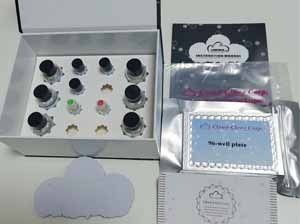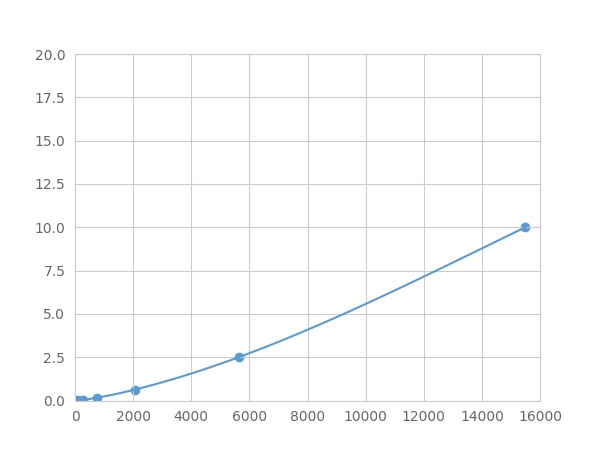Multiplex Assay Kit for Nerve Growth Factor (NGF) ,etc. by FLIA (Flow Luminescence Immunoassay) 

NGFB; Beta-NGF; HSAN5; NGF-B; Beta-Nerve Growth Factor
(Note: Up to 8-plex in one testing reaction)
- UOM
- FOB US$ 449.00 US$ 467.00 US$ 492.00 US$ 527.00 US$ 562.00 US$ 613.00 US$ 691.00 US$ 864.00
- Quantity
Overview
Properties
- Product No.LMA105Gu
- Organism SpeciesCavia (Guinea pig ) Same name, Different species.
- ApplicationsFLIA Kit for Antigen Detection.
Research use only - DownloadInstruction Manual
- CategoryCytokineNeuro science
Sign into your account
Share a new citation as an author
Upload your experimental result
Review

Contact us
Please fill in the blank.
Recovery
Matrices listed below were spiked with certain level of recombinant Nerve Growth Factor (NGF) ,etc. by FLIA (Flow Luminescence Immunoassay) and the recovery rates were calculated by comparing the measured value to the expected amount of Nerve Growth Factor (NGF) ,etc. by FLIA (Flow Luminescence Immunoassay) in samples.
| Matrix | Recovery range (%) | Average(%) |
| serum(n=5) | 78-99 | 91 |
| EDTA plasma(n=5) | 83-96 | 91 |
| heparin plasma(n=5) | 78-101 | 85 |
Precision
Intra-assay Precision (Precision within an assay): 3 samples with low, middle and high level Nerve Growth Factor (NGF) ,etc. by FLIA (Flow Luminescence Immunoassay) were tested 20 times on one plate, respectively.
Inter-assay Precision (Precision between assays): 3 samples with low, middle and high level Nerve Growth Factor (NGF) ,etc. by FLIA (Flow Luminescence Immunoassay) were tested on 3 different plates, 8 replicates in each plate.
CV(%) = SD/meanX100
Intra-Assay: CV<10%
Inter-Assay: CV<12%
Linearity
The linearity of the kit was assayed by testing samples spiked with appropriate concentration of Nerve Growth Factor (NGF) ,etc. by FLIA (Flow Luminescence Immunoassay) and their serial dilutions. The results were demonstrated by the percentage of calculated concentration to the expected.
| Sample | 1:2 | 1:4 | 1:8 | 1:16 |
| serum(n=5) | 98-105% | 79-91% | 90-101% | 85-93% |
| EDTA plasma(n=5) | 83-103% | 88-95% | 80-104% | 81-98% |
| heparin plasma(n=5) | 80-102% | 97-105% | 83-101% | 87-104% |
Stability
The stability of kit is determined by the loss rate of activity. The loss rate of this kit is less than 5% within the expiration date under appropriate storage condition.
To minimize extra influence on the performance, operation procedures and lab conditions, especially room temperature, air humidity, incubator temperature should be strictly controlled. It is also strongly suggested that the whole assay is performed by the same operator from the beginning to the end.
Reagents and materials provided
| Reagents | Quantity | Reagents | Quantity |
| 96-well plate | 1 | Plate sealer for 96 wells | 4 |
| Pre-Mixed Standard | 2 | Standard Diluent | 1×20mL |
| Pre-Mixed Magnetic beads (22#:NGF) | 1 | Analysis buffer | 1×20mL |
| Pre-Mixed Detection Reagent A | 1×120μL | Assay Diluent A | 1×12mL |
| Detection Reagent B (PE-SA) | 1×120μL | Assay Diluent B | 1×12mL |
| Sheath Fluid | 1×10mL | Wash Buffer (30 × concentrate) | 1×20mL |
| Instruction manual | 1 |
Assay procedure summary
1. Preparation of standards, reagents and samples before the experiment;
2. Add 100μL standard or sample to each well,
add 10μL magnetic beads, and incubate 90min at 37°C on shaker;
3. Remove liquid on magnetic frame, add 100μL prepared Detection Reagent A. Incubate 60min at 37°C on shaker;
4. Wash plate on magnetic frame for three times;
5. Add 100μL prepared Detection Reagent B, and incubate 30 min at 37°C on shaker;
6. Wash plate on magnetic frame for three times;
7. Add 100μL sheath solution, swirl for 2 minutes, read on the machine.

Test principle
Analyte-specific antibodies are pre-coated onto color-coded microparticles. Microparticles, standards, and samples are pipetted into wells and the immobilized antibodies bind the analytes of interest. After washing away any unbound substances, a biotinylated antibody cocktail specific to the analytes of interest is added to each well. Following a wash to remove any unbound biotinylated antibody, Streptavidin-Phycoerythrin conjugate (Streptavidin-PE), which binds to the biotinylated detection antibodies, is added to each well. A final wash removes unbound Streptavidin-PE and the microparticles are resuspended in buffer and read using the Luminex or Bio-Plex analyzer.The MFI developed is proportional to the concentration of analytes of interest in the sample.
Giveaways
Increment services
Citations
- Low-intensity aerobic exercise mitigates exercise-induced bronchoconstriction by improving the function of adrenal medullary chromaffin cells in asthmatic ratsPubmed:25212248
- Neurotrophic and antioxidant effects of silymarin comparable to 4-methylcatechol in protection against gentamicin-induced ototoxicity in guinea pigsPubmed:25445537
- NGF and HB-EGF: Potential Biomarkers that Reflect the Effects of Fesoterodine in Patients with Overactive Bladder SyndromePubmed:25510766
- High glucose upregulates CYP24A1 expression which attenuates the ability of 1,25(OH)2D3 to increase NGF secretion in a rat Schwann cell line RSC96Pubmed:25614971
- High glucose upregulates CYP24A1 expression which attenuates the ability of 1,25(OH)2D3PubMed: 25614971
- Telmisartan inhibits hyperalgesia and inflammatory progression in a diabetic neuropathic pain model of Wistar rats.PubMed: 25864063
- Pro-apoptotic Action of Corticosterone in Hippocampal Organotypic CulturesPubmed:27189478
- Chronic mild stress influences nerve growth factor through a matrix metalloproteinase-dependent mechanismPubmed:26771945
- Changes in growth factor levels in the cerebrospinal fluid of autism patients after transplantation of human umbilical cord blood mononuclear cells and umbilical cord-derived mesenchymal stem cellsPubmed:27323064
- Differential expression of cord blood neurotrophins in gestational diabetes: the impact of fetal growth abnormalitiespubmed:28081639
- An Intranasal Formulation of Erythropoietin (Neuro-EPO) Prevents Memory Deficits and Amyloid Toxicity in the APPSwe Transgenic Mouse Model of Alzheimer's …articles:journal-of-alzheimers-disease
- Evaluación de la secreción de factores neurotróficos por las células MSV en cocultivo con neurorretinas porcinas, en función de la dosis celular y del tiempo de cultivo10324/27440
- Antidepressant drugs for beta amyloid-induced depression: A new standpoint?pubmed:28499898
- Mechanical loading of intervertebral disc modulates microglia proliferation, activation, and chemotaxisPubmed:29723636
- Autophagy is required for human umbilical cord mesenchymal stem cells to improve spatial working memory in APP/PS1 transgenic mouse modelPubmed:29335016
- N-3 PUFA diet enrichment prevents amyloid beta-induced depressive-like phenotypePubmed:29203442
- Preterm umbilical cord blood derived mesenchymal stem/stromal cells protect preterm white matter brain development against hypoxia-ischemiaPubmed:30012511
- Effects of n-3 PUFA enriched and n-3 PUFA deficient diets in naïve and Aβ-treated female ratsPubmed:30028991
- 3‐‐Laurylglyceryl ascorbate improves the development of sensitive skin through the reduction of oxidative stressPubmed: 30698879
- Administration of Repetitive Transcranial Magnetic Stimulation Attenuates Aβ1-42-Induced Alzheimer's Disease in Mice by Activating β-Catenin Signaling
- A novel xeno-free culture system for human retinal pigment epithelium cellsPubmed: 31024807
- Involvement of neurotrophic signaling in doxorubicin‑induced cardiotoxicityPubmed: 32010279
- Inhibition of Receptor for Advanced Glycation End Products as New Promising Strategy Treatment in Diabetic RetinopathyPubmed: 32165929
- Hyperlipidemia Down‐Regulate Brain Antioxidant Defense Enzymes and Neurotrophins in Rats: Assessment of the Modulatory Potential of EPA+ DHA and …Pubmed: 32918393
- Impaired LTD-like motor cortical plasticity in female patients with major depression disorderPubmed: 32791084
- Effects of gold nanoparticles administration through behavioral and oxidative parameters in animal model of parkinson's diseasePubmed: 32777662
- Neurobiological determinants of depressive-like symptoms in rodents
- Changes of substance P, NGF and CGRP salivary levels among patients undergoing physical therapy
- Multiple-component dual-phase solid lipid nanoparticles with conjugated transferrin for formulating antioxidants and nerve growth factor against neuronal apoptosis
- Increased serum brain-derived neurotrophic factor and adrenocorticotropic hormone levels are associated with obsessive compulsive disorder in medication?free?¡33389158
- Neuroprotective effect of Na+/H+?exchangers isoform©\1 inactivation against 6©\hydroxydopamine©\induced mitochondrial dysfunction and neuronal apoptosis in Parkinson's disease models33538000
- Sea urchin gangliosides exhibit neuritogenic effects in neuronal PC12 cells via TrkA- and TrkB-related pathways33589896
- Repetitive Transcranial Magnetic Stimulation Improves Mild Cognitive Impairment Associated with Alzheimer's Disease in Mice by Modulating the miR-567 …34239303
- Carissa macrocarpa Leaves Polar Fraction Ameliorates Doxorubicin-Induced Neurotoxicity in Rats via Downregulating the Oxidative Stress and Inflammatory Markers34959705
- CNTs‐CaP/chitosan‐coated AZ91D magnesium alloy extract promoted rat dorsal root ganglia neuron growth via activating ERK signalling pathway34296452
- Gene delivery of chitosan-graft-polyethyleneimine vectors loaded on scaffolds for nerve regenerationPubmed:35550777








